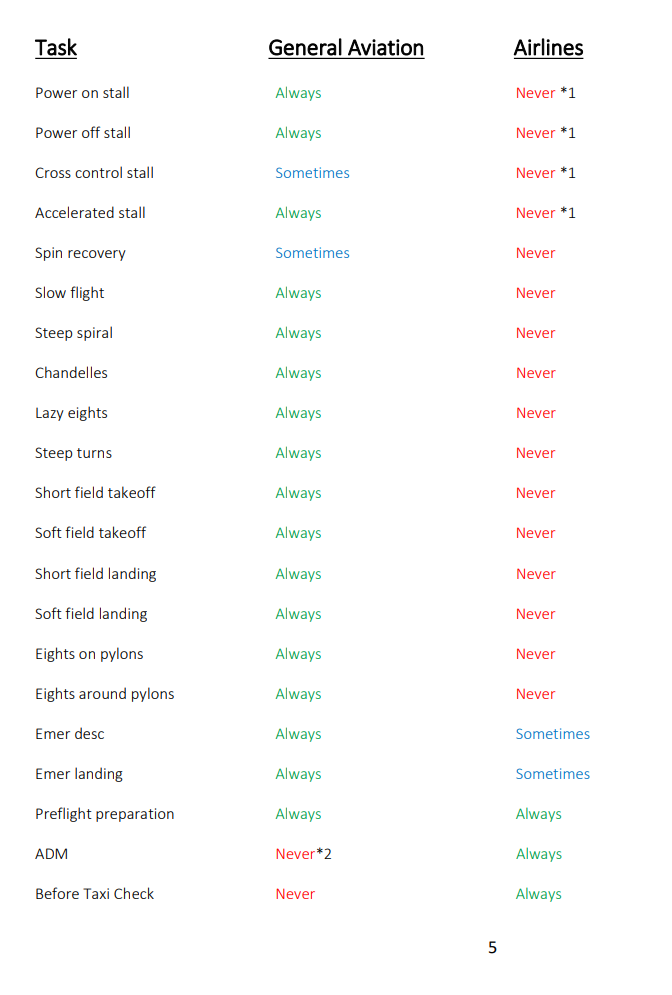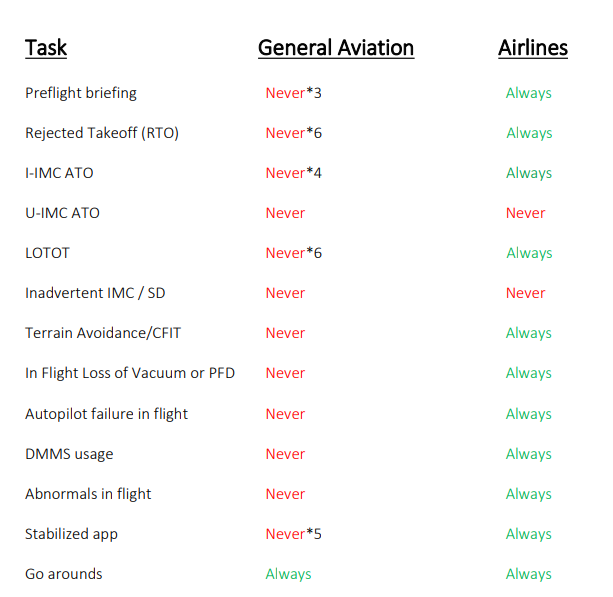From that document:


The main point is that the check rides focus on the kind of flying you actually do. Maneuvering between treetops trying to hit the spot on a short grass field has nothing to do with stabilized approach or terrain avoidance etc. It does have everything to do with slow flying skills, soft/short field, avoiding stall and those kind of things.
GA is not airline, but if you want to, you certainly can fly most GA planes the same manner that airlines fly  However, this does not work the other way around
However, this does not work the other way around 
Besides, what happened to “free as a bird” ? GA is NOT airline. Airline is dead boring bus driving skills. Bogged down in procedures and restrictions for the safety of the passengers, and the peace of mind of the members of the executive board. If you want to bog yourself down in the same procedures and restrictions, you certainly can do that. Nothing is stopping you. Just stop telling me that this is in any sort of way the “right” way also for me, and the “right” way for GA in general.
LeSving wrote:
Just stop telling me that this is in any sort of way the “right” way also for me, and the “right” way for GA in general.
Well, if you regularly do steep turns and fly below 1,3xVso on approaches, then certainly you should do that also in recurrent training! However, I don’t, not even in the Voluntary Air Corps where we occasionally fly at 200 ft AGL.
Clearly the video is for the US context where pilots fly a lot but mainly long straight lines, and only see a CFI once every 2 years to do the BFR.
From the fatal accidents I gathered, the 2 manoeuvers one can work to reduce are :
- EFATO
- inadvertent entry in IMC
No big surprise  But those are only 1/4 of fatal accidents.
But those are only 1/4 of fatal accidents.
The main cause of fatal crashes is wrong decision-making (more than half of them) which led to CFIT or LOC in IMC
The others are either EFATOs or unexplained, which is tricky. We don’t know what kills most during safe-looking flights (I mean short locals in blue sky).
About EFATOs, “only” 2 were fatal out of 8 I found on the BEA website.
Of these 8, 2 were caused by selecting the empty fuel tank instead of the full 

CFIT accidents are less related to terrain awarness but they have to do with lack of GA aircraft climb/turn performance, if one hears a 500ft agl terrain warning when not expecting it, they are 95% dead whatever they do with stick as they will barely achieve 5deg gradients or less than 6000ft turns, I don’t think this will change this in the future anytime soon
LOC in IMC can be sorted by AP, usually those who fly that long in IMC will have decent autopilots, LOC in VMC belongs to training but mainly caused by distractions for those flying unintentially bellow 1.3×Vs0, I don’t think this will go down as the cause is very complex to solve
Fuel starvation, engine failures, gear up, botched takeoff, botched landing, wrong flaps… will be hanging around but usually people can walk away from these but with huge financial bill 
GA is NOT airline.
Certainly not for me, but a clear majority of regular EuroGA contributors do fly by numbers, procedures and rules – just like the expert simulator pilots who killed their passengers and crew on AF447.
That’s the joy of GA. It’s a broad spectrum, and if some people feel safe always remaining so far within the “book” flight envelope that they would struggle to regain control after ceding or losing it, that’s their business and I’ll be the last to criticise them.
Airborne_Again wrote:
However, I don’t, not even in the Voluntary Air Corps where we occasionally fly at 200 ft AGL.
Every now and then even the most hard core Air Corps pilot need to land  Landing sometimes include flying lower than 200 ft AGL. My point was that as GA pilots we do whatever we “need” to do, and very often this is very far from what airline pilots “need” to do, but sometimes it is exactly the same. You cannot possibly expect everybody to know everything at any given moment. A typical private GA pilot flies way too little to have any possibility of practically achieving that. That would be the same for all other pilots as well. Therefore, focusing on a very basic skill-set about aircraft handling is a good solution. As GA pilots we don’t have the luxury of peeling off “unnecessary” sets of skills, as airline pilots can (whether they actually do or don’t).
Landing sometimes include flying lower than 200 ft AGL. My point was that as GA pilots we do whatever we “need” to do, and very often this is very far from what airline pilots “need” to do, but sometimes it is exactly the same. You cannot possibly expect everybody to know everything at any given moment. A typical private GA pilot flies way too little to have any possibility of practically achieving that. That would be the same for all other pilots as well. Therefore, focusing on a very basic skill-set about aircraft handling is a good solution. As GA pilots we don’t have the luxury of peeling off “unnecessary” sets of skills, as airline pilots can (whether they actually do or don’t).
Ibra, you are right.
But the accidents in question happened after dozens of minutes of scud-running (most very low in hilly terrain, one high level over the alps, close to service cieiling).
Some ended in CFIT, some in LOC in IMC, but it was the same profile. Some stayed out of clouds but hit a hill, some got in the layer and lost control.
In the video, they show that US pilots encounter about 1 fatal accident per 100k hours.
With the statistics I have :
- 7 fatal accidents in french clubs in 2018
- 522 k hours in french clubs in 2018
we are at 1,34 fatal accident per 100 k hours !!
34% more than US GA 
Jujupilote wrote:
Of these 8, 2 were caused by selecting the empty fuel tank instead of the full
Indeed! So maybe we should train fuel exhaustion in flight? There was an accident in Sweden the other year where a PA28 pilot unexpectedly ran one tank dry. He initially did everything right according to the checklist, but when the engine didn’t restart again immediately he switched back to the empty tank. He then continued to switch between the empty and non-empty tank rapidly enough that the engine never got a chance to restart. He made a successful emergency landing in the sense that everyone walked away, but the aircraft was totalled.
LeSving wrote:
You cannot possibly expect everybody to know everything at any given moment. A typical private GA pilot flies way too little to have any possibility of practically achieving that. That would be the same for all other pilots as well. Therefore, focusing on a very basic skill-set about aircraft handling is a good solution. As GA pilots we don’t have the luxury of peeling off “unnecessary” sets of skills, as airline pilots can (whether they actually do or don’t).
Precisely because of that maybe should indeed peel off “unnecessary” skills.